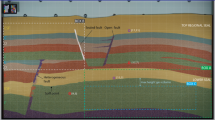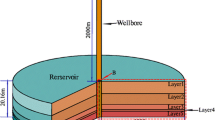Abstract
Geologic storage of CO2 is expected to produce plumes of large areal extent, and some leakage may occur along fractures, fault zones, or improperly plugged pre-existing wellbores. A review of physical and chemical processes accompanying leakage suggests a potential for self-enhancement. The numerical simulations presented here confirm this expectation, but reveal self-limiting features as well. It seems unlikely that CO2 leakage could trigger a high-energy run-away discharge, a so-called “pneumatic eruption,” but present understanding is insufficient to rule out this possibility. The most promising avenue for increasing understanding of CO2 leakage behavior is the study of natural analogues.







Similar content being viewed by others
References
Bachu S, Nordbotten JM, Celia MA (2004) Evaluation of the spread of acid-gas plumes injected in deep saline aquifers in Western Canada as an analogue for CO2 injection into continental sedimentary basins. Paper 12, presented at 7th international conference on greenhouse gas control technologies, Vancouver, Canada, 5–9 September
Barnes I, Irwin WP, White DE (1978) Global distribution of carbon dioxide discharges, and major zones of Seismicity, scale 1:40,000,000, in Water Resour Invest, Open File Report 78-39, 11 pp, US Geological Survey, Washington, DC
Benson SM, Hepple R, Apps J, Tsang CF, Lippmann M (2002) Lessons learned from natural and industrial analogues for storage of carbon dioxide in deep geological formations, Lawrence Berkeley National Laboratory Report LBNL-51170, Berkeley, CA
Bowden AR, Rigg A (2004) Assessing reservoir performance risk in CO2 storage projects. Paper 547, presented at 7th international conference on greenhouse gas control technologies, Vancouver, Canada, 5–9 September
Browne PRL, Lawless JV (2001) Characteristics of hydrothermal eruptions, with examples from New Zealand and elsewhere. Earth Sci Rev 52:299–331
Celia M, Bachu S, Nordbotten JM, Gasda SE, Dahle HK (2004) Quantitative estimation of CO2 leakage from geological storage: analytical models, numerical models, and data needs. Paper 228, presented at 7th international conference on greenhouse gas control technologies, Vancouver, Canada, 5–9 September
Chiodini G, Cardellini C, Amato A, Boschi E, Caliro S, Frondini F, Ventura G (2004) Carbon dioxide degassing and seismogenesis in central and Southern Italy. Geophys Res Lett 31:L07615. doi:10.1029/2004GL019480
Chivas AR, Barnes I, Evans WC, Lupton JE, Stone JO (1987) Liquid carbon dioxide of magmatic origin and its role in volcanic eruptions. Nature 326:587–589
Duguid A, Radonjic M, Bruant R, Mandecki T, Scherer G, Celia M (2004) The effect of CO2 sequestration on oil well cements. Paper 123, presented at 7th international conference on greenhouse gas control technologies, Vancouver, Canada, 5–9 September
Espie T (2004) Understanding risk for the long-term storage of CO2 in geologic formations. Paper 42, presented at 7th international conference on greenhouse gas control technologies, Vancouver, Canada, 5–9 September
Evans JP, Heath J, Shipton ZK, Kolesar PT, Dockrill B, Williams A, Kirchner D, Lachmar TE, Nelson ST (2004) Natural leaking CO2-charged systems as analogs for geologic sequestration sites. Paper presented at 3rd annual conference on carbon capture and sequestration. Alexandria, VA, May
Evans WC, Sorey ML, Cook AC, Kennedy BM, Shuster DL, Colvard EM, White LD, Huebner MA (2002) Tracing and quantifying magmatic carbon discharge in cold groundwaters: lessons learned from Mammoth Mountain, USA. J Volcanol Geoth Res 114(3–4):291–312
Fischer TP, Arehart GB, Sturchio NC, Williams SN (1996) The relationship between fumarole gas composition and eruptive activity at Galeras volcano, Colombia. Geology 24(6):531–534
Gherardi F, Xu T, Pruess K (2005) Coupled hydrodynamic-geochemical modelling of CO2-driven water-rock interactions into sealed and fractured caprock formations. Paper presented at Geoitalia 2005, 5th Italian forum of earth sciences, Spoleto/Italy, 21–23 September
Gibson-Poole CM, Root RS, Lang SC, Streit JE, Hennig AL, Otto CJ, Underschultz J (2004) Conducting comprehensive analyses of potential sites for geological CO2 storage. Paper 321, presented at 7th international conference on greenhouse gas control technologies, Vancouver, Canada, 5–9 September
Giggenbach WF, Sano Y, Schmincke HU (1991) CO2-rich gases from lakes Nyos and Monoun, Cameroon; Lacher See, Germany; Dieng, Indonesia, and Mt. Gambier, Australia—variations on a common theme. J Volcanol Geoth Res 45:311–323
Ha-Duong M, Keith DW (2003) Carbon storage: the economic efficiency of storing CO2 in leaky reservoirs. Clean Technol Environ Policy 5:181–189. doi:10.1007/s10098-003-0213-z
Hawkins DG (2004) No exit: thinking about leakage from geologic carbon storage sites. Energy 29:1571–1578
Hepple RP, Benson S (2003) Implications of surface seepage on the effectiveness of geologic storage of carbon dioxide as a climate change mitigation strategy. In: Gale J, Kaya Y (eds) Greenhouse gas control technologies. Elsevier Science, Amsterdam, The Netherlands, pp 261–266
Hitchon B (1996) (ed) Aquifer disposal of carbon dioxide. Geoscience Publishing, Sherwood Park, AB, Canada
Hoth N, Schlömann M, Kassahun A, Glombitza F, Häfner F (2005) Recycling of sequestered CO2 by microbial-biogeochemical transformation in the deep subsurface (RECOBIO). In: Stroink L (ed) Investigation, Utilization and protection of the underground, Geotechnologien Science Report No. 6, Geoforschungszentrum Potsdam, Germany
Katz DL, Lee RL (1990) Natural gas engineering. McGraw-Hill Publ Comp, New York, NY
Krooss BM, Hildenbrand A, Alles S, Littke R, Pearce J (2004) Assessment of the CO2 sealing efficiency of pelitic rocks: two-phase flow and diffusive transport. Paper 536, presented at 7th international conference on greenhouse gas control technologies, Vancouver, Canada, 5–9 September
Lemmon EW, McLinden MO, Friend DG (2005) Thermophysical properties of fluid systems. In: Linstrom PJ, Mallard WG (eds) NIST chemistry webbook, NIST standard reference database number 69 June 2005, National Institute of Standards and Technology, Gaithersburg MD, 20899 (http://webbook.nist.gov)
Lindeberg E (2003) The quality of a CO2 repository: what is the sufficient retention time of CO2 stored underground? In: Gale J, Kaya Y (eds) Greenhouse gas control technologies. Elsevier Science, Amsterdam, The Netherlands, pp 255–260
Lindeberg E, Bergmo P (2003) The long-term fate of CO2 injected into an aquifer. In: Gale J, Kaya Y (eds) Greenhouse gas control technologies. Elsevier Science, Amsterdam, The Netherlands, pp 489–494
Lu X (2004) An investigation of transient two-phase flow in vertical pipes with particular reference to geysering. Ph.D. thesis, The University of Auckland, New Zealand
Maul P, Savage D, Benbow S, Walker R, Bruin R (2004) Development of a FEP database for the geological storage of carbon dioxide. Paper 580, presented at 7th international conference on greenhouse gas control technologies, Vancouver, Canada, 5–9 September
Moreno FJ, Chalaturnyk R, Jimenez J (2004) Methodology for assessing integrity of bounding seals (Wells and Caprock) for geological storage of CO2. Paper 586, presented at 7th international conference on greenhouse gas control technologies, Vancouver, Canada, 5–9 September
Nordbotten JM, Celia MA, Bachu S (2004) Analytical solutions for leakage rates through abandoned wells. Water Resour Res 40:W04204. doi:10.1029/2003WR002997
Pacala SW (2003) Global constraints on reservoir leakage. In: Gale J, Kaya Y (eds) Greenhouse gas control technologies. Elsevier Science, Amsterdam, The Netherlands, pp 267–272
Pruess K (2005a) Numerical simulations show potential for strong non-isothermal effects during fluid leakage from a geologic disposal reservoir for CO2. In: Faybishenko B, Witherspoon PA, Gale J (eds) Dynamics of fluids and transport in fractured rock, geophysical monograph 162. American Geophysical Union, Washington, DC, pp 81–89
Pruess K (2005b) Numerical studies of fluid leakage from a geologic disposal reservoir for CO2 show self-limiting feedback between fluid flow and heat transfer. Geophys Res Lett 32(14):L14404. doi:10.1029/2005GL023250
Pruess K (2005c) ECO2N: a TOUGH2 fluid property module for mixtures of water, NaCl, and CO2, Lawrence Berkeley National Laboratory Report LBNL-57592, Berkeley, CA
Pruess K (2004) Numerical simulation of CO2 leakage from a geologic disposal reservoir, including transitions from super- to sub-critical conditions, and boiling of liquid CO2. Soc Pet Eng J 237–248
Pruess K, Xu T, Apps J, Garcia J (2003) Numerical modeling of aquifer disposal of CO2, Paper SPE-83695. SPE J 49–60
Pruess K, Garcia J (2002) Multiphase flow dynamics during CO2 injection into saline aquifers. Environ Geol 42:282–295
Rutqvist J, Tsang CF (2002) A study of caprock hydromechanical changes associated with CO2 injection into a brine formation. Environ Geol 42:296–305
Rutqvist J, Tsang CF (2005) Coupled hydromechanical effects of CO2 injection. In: Tsang CF, Apps JA (eds) Underground injection science and technology. Elsevier, Amsterdam, pp 649–679
Shi H, Holmes JA, Durlofsky LJ, Aziz K, Diaz LR, Alkaya B, Oddie G (2005) Drift-flux modeling of two-phase flow in wellbores. Soc Pet Eng J 24–33
Shipton ZK, Evans JP, Kirschner D, Kolesar PT, Williams AP, Heath J (2004) Analysis of CO2 leakage through ‘low-permeability’ faults from natural reservoirs in the Colorado Plateau, East-central Utah. In: Baines SJ, Worden RH (eds) Geological storage of carbon dioxide, vol 233. Geological Society, London, Special Publications, London, England, pp 43–58
Sigurdsson H, Devine JD, Tchoua FM, Presser TS, Pringle MKW, Evans WC (1987) Origin of the lethal gas burst from Lake Monoun, Cameroon. J Volcanol Geoth Res 31:1–16
Skinner L (2003) CO2 blowouts: an emerging problem. World Oil 224(1)
Sorey ML, Evans WC, Kennedy BM, Farrar CD, Hainsworth LJ, Hausback B (1998) Carbon dioxide and helium emissions from a reservoir of magmatic gas beneath Mammoth Mountain, California. J Geophys Res 103(B7):15303–15324
Streit JE, Hillis RR (2003) Building geomechanical models for the safe underground storage of carbon dioxide in porous rock. In: Gale J, Kaya Y (eds) Greenhouse gas control technologies. Elsevier Science, Amsterdam, The Netherlands, pp 495–500
Streit JE, Hillis RR (2004) Estimating fault stability and sustainable fluid pressures for underground storage of CO2 in porous rock. Energy 29:1445–1456
Streit JE, Watson MN (2004) Estimating rates of potential CO2 loss from geological storage sites for risk and uncertainty analysis. Paper 152, presented at 7th international conference on greenhouse gas control technologies, Vancouver, Canada, 5–9 September
Tazieff H (1991) Mechanism of the Nyos carbon dioxide disaster and of so-called phreatic steam eruptions. J Volcanol Geoth Res 391:109–116
Walton FB, Tait JC, LeNeveu D, Sheppard MI (2004) Geological storage of CO2: a statistical approach to assessing performance and risk. Paper 581, presented at 7th international conference on greenhouse gas control technologies, Vancouver, Canada, 5–9 September
Wassink J (2005) Dodelijke mist [Deadly Mist; in Dutch], Het Inzicht [The Insight] (http://www.inzicht.box.nl/prod_art.htm, accessed 29 April 2006)
Wikipedia (2004): http://en.wikipedia.org/wiki/Megaton. Accessed 6 Dec 2004
Wildenborg T, Leijnse T, Kreft E, Nepveu M, Obdam A (2004) Long-term safety assessment of CO2 storage: the scenario approach. Paper 540, presented at 7th international conference on greenhouse gas control technologies, Vancouver, Canada, 5–9 September
Zuber N, Findlay JA (1965) Average volumetric concentration in two-phase flow systems. J Heat Transfer Trans ASME 87(4):453–468
Zweigel P, Lindeberg E, Moen A, Wessel-Berg D (2004) Towards a methodology for top seal efficacy assessment for underground CO2 storage. Paper 234, presented at 7th international conference on greenhouse gas control technologies, Vancouver, Canada, 5–9 September
Acknowledgments
The author acknowledges helpful discussions with John Apps, Jens Birkholzer, Chin-Fu Tsang and Sally Benson. Jens Birkholzer and two anonymous reviewers are thanked for their careful review of the manuscript and the suggestion of improvements. This work was supported by the Zero Emission Research and Technology project (ZERT) under Contract No. DE-AC02-05CH11231 with the US Department of Energy.
Author information
Authors and Affiliations
Corresponding author
Rights and permissions
About this article
Cite this article
Pruess, K. On CO2 fluid flow and heat transfer behavior in the subsurface, following leakage from a geologic storage reservoir. Environ Geol 54, 1677–1686 (2008). https://doi.org/10.1007/s00254-007-0945-x
Received:
Accepted:
Published:
Issue Date:
DOI: https://doi.org/10.1007/s00254-007-0945-x




